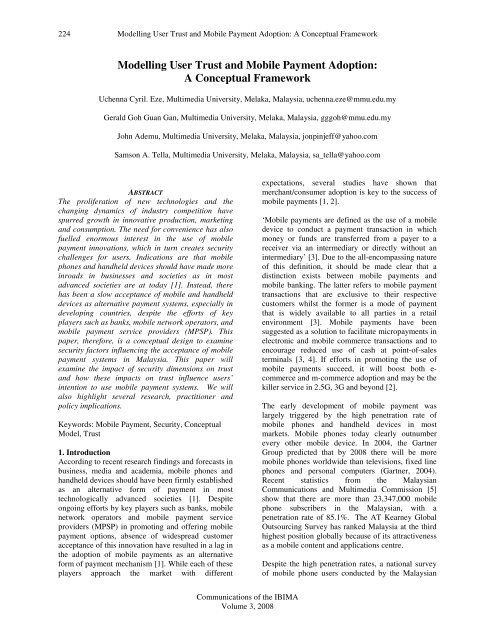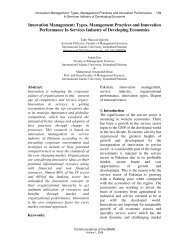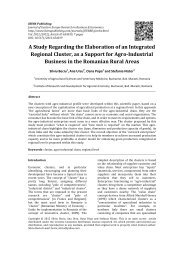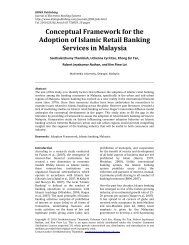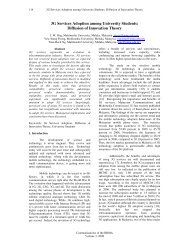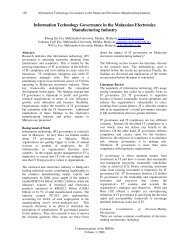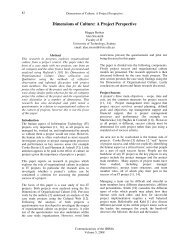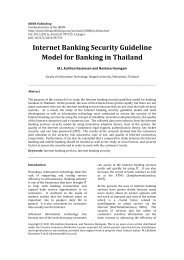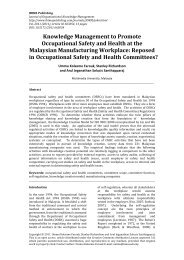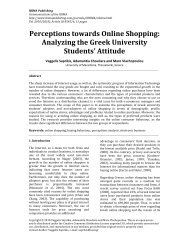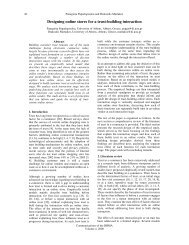Modelling User Trust and Mobile Payment Adoption - IBIMA Publishing
Modelling User Trust and Mobile Payment Adoption - IBIMA Publishing
Modelling User Trust and Mobile Payment Adoption - IBIMA Publishing
Create successful ePaper yourself
Turn your PDF publications into a flip-book with our unique Google optimized e-Paper software.
224<br />
<strong>Modelling</strong> <strong>User</strong> <strong>Trust</strong> <strong>and</strong> <strong>Mobile</strong> <strong>Payment</strong> <strong>Adoption</strong>: A Conceptual Framework<br />
<strong>Modelling</strong> <strong>User</strong> <strong>Trust</strong> <strong>and</strong> <strong>Mobile</strong> <strong>Payment</strong> <strong>Adoption</strong>:<br />
A Conceptual Framework<br />
Uchenna Cyril. Eze, Multimedia University, Melaka, Malaysia, uchenna.eze@mmu.edu.my<br />
Gerald Goh Guan Gan, Multimedia University, Melaka, Malaysia, gggoh@mmu.edu.my<br />
John Ademu, Multimedia University, Melaka, Malaysia, jonpinjeff@yahoo.com<br />
Samson A. Tella, Multimedia University, Melaka, Malaysia, sa_tella@yahoo.com<br />
ABSTRACT<br />
The proliferation of new technologies <strong>and</strong> the<br />
changing dynamics of industry competition have<br />
spurred growth in innovative production, marketing<br />
<strong>and</strong> consumption. The need for convenience has also<br />
fuelled enormous interest in the use of mobile<br />
payment innovations, which in turn creates security<br />
challenges for users. Indications are that mobile<br />
phones <strong>and</strong> h<strong>and</strong>held devices should have made more<br />
inroads in businesses <strong>and</strong> societies as in most<br />
advanced societies are at today [1]. Instead, there<br />
has been a slow acceptance of mobile <strong>and</strong> h<strong>and</strong>held<br />
devices as alternative payment systems, especially in<br />
developing countries, despite the efforts of key<br />
players such as banks, mobile network operators, <strong>and</strong><br />
mobile payment service providers (MPSP). This<br />
paper, therefore, is a conceptual design to examine<br />
security factors influencing the acceptance of mobile<br />
payment systems in Malaysia. This paper will<br />
examine the impact of security dimensions on trust<br />
<strong>and</strong> how these impacts on trust influence users’<br />
intention to use mobile payment systems. We will<br />
also highlight several research, practitioner <strong>and</strong><br />
policy implications.<br />
Keywords: <strong>Mobile</strong> <strong>Payment</strong>, Security, Conceptual<br />
Model, <strong>Trust</strong><br />
1. Introduction<br />
According to recent research findings <strong>and</strong> forecasts in<br />
business, media <strong>and</strong> academia, mobile phones <strong>and</strong><br />
h<strong>and</strong>held devices should have been firmly established<br />
as an alternative form of payment in most<br />
technologically advanced societies [1]. Despite<br />
ongoing efforts by key players such as banks, mobile<br />
network operators <strong>and</strong> mobile payment service<br />
providers (MPSP) in promoting <strong>and</strong> offering mobile<br />
payment options, absence of widespread customer<br />
acceptance of this innovation have resulted in a lag in<br />
the adoption of mobile payments as an alternative<br />
form of payment mechanism [1]. While each of these<br />
players approach the market with different<br />
expectations, several studies have shown that<br />
merchant/consumer adoption is key to the success of<br />
mobile payments [1, 2].<br />
‘<strong>Mobile</strong> payments are defined as the use of a mobile<br />
device to conduct a payment transaction in which<br />
money or funds are transferred from a payer to a<br />
receiver via an intermediary or directly without an<br />
intermediary’ [3]. Due to the all-encompassing nature<br />
of this definition, it should be made clear that a<br />
distinction exists between mobile payments <strong>and</strong><br />
mobile banking. The latter refers to mobile payment<br />
transactions that are exclusive to their respective<br />
customers whilst the former is a mode of payment<br />
that is widely available to all parties in a retail<br />
environment [3]. <strong>Mobile</strong> payments have been<br />
suggested as a solution to facilitate micropayments in<br />
electronic <strong>and</strong> mobile commerce transactions <strong>and</strong> to<br />
encourage reduced use of cash at point-of-sales<br />
terminals [3, 4]. If efforts in promoting the use of<br />
mobile payments succeed, it will boost both e-<br />
commerce <strong>and</strong> m-commerce adoption <strong>and</strong> may be the<br />
killer service in 2.5G, 3G <strong>and</strong> beyond [2].<br />
The early development of mobile payment was<br />
largely triggered by the high penetration rate of<br />
mobile phones <strong>and</strong> h<strong>and</strong>held devices in most<br />
markets. <strong>Mobile</strong> phones today clearly outnumber<br />
every other mobile device. In 2004, the Gartner<br />
Group predicted that by 2008 there will be more<br />
mobile phones worldwide than televisions, fixed line<br />
phones <strong>and</strong> personal computers (Gartner, 2004).<br />
Recent statistics from the Malaysian<br />
Communications <strong>and</strong> Multimedia Commission [5]<br />
show that there are more than 23,347,000 mobile<br />
phone subscribers in the Malaysian, with a<br />
penetration rate of 85.1%. The AT Kearney Global<br />
Outsourcing Survey has ranked Malaysia at the third<br />
highest position globally because of its attractiveness<br />
as a mobile content <strong>and</strong> applications centre.<br />
Despite the high penetration rates, a national survey<br />
of mobile phone users conducted by the Malaysian<br />
Communications of the <strong>IBIMA</strong><br />
Volume 3, 2008
Uchenna Cyril. Eze, Gerald Goh Guan Gan,John Ademu <strong>and</strong> Samson A. Tella<br />
225<br />
Communications <strong>and</strong> Multimedia Commission in<br />
2006 revealed that only 17.6% of mobile phone users<br />
had actually purchased products or services using<br />
their mobile phones [6]. Recent examples of not too<br />
successful uptake of electronic payment systems<br />
indicate that better underst<strong>and</strong>ing of the adoption of<br />
payment systems by consumers is needed to guide<br />
future development of <strong>Mobile</strong> <strong>Payment</strong>s [3].While<br />
this issue has been raised in several studies, most of<br />
these studies are exploratory <strong>and</strong> there is limited data<br />
on the adoption of mobile payment systems by<br />
consumers, more so for the Malaysian scenario.<br />
This study analyzes the complex environment of<br />
mobile payments <strong>and</strong> focuses on examining<br />
consumer willingness to use mobile phones as a<br />
payment instrument in transactions where money is<br />
transferred from consumer to merchant in exchange<br />
for products or services. It is pertinent to stress that<br />
several electronic payment schemes have failed to<br />
achieve the much desired critical mass required. Well<br />
known cases of failures include eCash, ePurse <strong>and</strong><br />
some other electronic smart card schemes [7]. Most<br />
schemes failed because the focus of awareness<br />
campaigns were based largely on technical aspects<br />
that were of little importance to customers. There is a<br />
need to make sure that security issues are adequately<br />
addressed <strong>and</strong> designed in alignment to the subjective<br />
perceptions of potential consumers [7]. To our<br />
knowledge, there are currently no findings from an<br />
empirical survey of consumer perceptions on mobile<br />
payment in Malaysia. As such, this paper aims to<br />
examine the extant literature on the role of security in<br />
the adoption of mobile payments amongst mobile<br />
phone users in Malaysia. This study will explore the<br />
drivers, determinants <strong>and</strong> factors of security that may<br />
affect consumer adoption of mobile phones as an<br />
alternative means of payment by proposing a<br />
conceptual model that examines trust <strong>and</strong> mobile<br />
payments adoption.<br />
2. The <strong>Mobile</strong> <strong>Payment</strong> Arena<br />
Today’s mobile payment arena is non-st<strong>and</strong>ardized<br />
with major players approaching the market with their<br />
own proprietary infrastructures <strong>and</strong> solutions.<br />
Concerning payment models, there currently is no<br />
widely accepted, dominating or st<strong>and</strong>ardized mobile<br />
payment model. There are about four existing mobile<br />
payment models i.e. acquirer-centric, user-centric,<br />
bank-centric <strong>and</strong> mobile network operator centric<br />
models. Karnouskos [2] states that the most likely<br />
dominant players in the arena would be banks <strong>and</strong><br />
mobile network operators (MNO). He foresees a<br />
movement towards composite models where the main<br />
players cooperate on a revenue sharing basis.<br />
Most payment transactions consist of three basic<br />
phases. First the consumer chooses the desired<br />
product by shopping. After the shopping phase, the<br />
customer is billed by the merchant. Finally, the<br />
customer pays the merchant for the good. According<br />
to Ondrus <strong>and</strong> Pigneur [8], there are many<br />
possibilities of extending the number of phases<br />
during a payment transaction. The most pertinent<br />
issue is that the transaction must be easy to use to the<br />
customer regardless of how complex the transaction<br />
may be. The mobile payment scenario currently has<br />
several proprietary models in terms of transaction<br />
scenarios.<br />
3. Categorization of typical mobile payment<br />
procedures<br />
While the key phases of the generic mobile payment<br />
procedure is applicable to almost all transactions,<br />
they can be categorised into several different groups<br />
or procedures based. Karnouskos [2] categorises<br />
mobile payment procedures them as location-based<br />
(remote <strong>and</strong> proximity Transactions), value-based<br />
(micro-payments, mini-payments <strong>and</strong> macropayments),<br />
charge-based (post-paid, pre-paid <strong>and</strong><br />
pay-now), validation-based (online mobile payment,<br />
offline mobile payment) <strong>and</strong> technology-based<br />
(single chip, dual chip, dual slot), token-based (ecoin)<br />
<strong>and</strong> account-based (wireless wallets).<br />
Location of purchase has been the key determinant in<br />
driving various forms of electronic payments as<br />
evidenced in several studies. <strong>Mobile</strong> payment is<br />
expected to further drive the market with the<br />
introduction of new features. <strong>Mobile</strong> phones have<br />
been used as wallets in several payment scenarios.<br />
Nokia <strong>and</strong> Master Card have conducted several joint<br />
tests since 2003. Proximity payments usually involve<br />
two parties using an ad-hoc network based on<br />
wireless technologies such as Bluetooth, infrared <strong>and</strong><br />
radio frequency identification (RFID) which enable<br />
short-range wireless device to device payments.<br />
Recently there have been research <strong>and</strong> developments<br />
into a new technology called near field<br />
communications (NFC). NFC is a short-range<br />
wireless technology like RFID tags, which are used<br />
to track stock by retailers. The tags inside phones<br />
could have personal information stored in them <strong>and</strong><br />
could act as car keys, money, tickets <strong>and</strong> travel cards.<br />
<strong>Mobile</strong> firms representing 40% of the global mobile<br />
market back NFC. The potential inhibiting factors<br />
may be the risks involved like non-repudiation.<br />
Communications of the <strong>IBIMA</strong><br />
Volume 3, 2008
226<br />
<strong>Modelling</strong> <strong>User</strong> <strong>Trust</strong> <strong>and</strong> <strong>Mobile</strong> <strong>Payment</strong> <strong>Adoption</strong>: A Conceptual Framework<br />
4. Factors influencing the adoption of mobile<br />
payments<br />
The diffusion of innovations theory has played an<br />
important role in providing a theoretical framework<br />
for the study of information technology adoption by<br />
both individuals <strong>and</strong> organisations. Using the<br />
diffusion of innovations theory proposed <strong>and</strong> later<br />
refined by Rogers (1995), numerous models <strong>and</strong><br />
frameworks have emerged to address the adoption of<br />
information technology <strong>and</strong> its related applications.<br />
Many of these models analyse the behavioural<br />
aspects of the adopters such as perception, attitude<br />
<strong>and</strong> motivation, often integrating diffusion of<br />
innovations literature with other theories or models.<br />
Among the models that have been developed to<br />
provide an underst<strong>and</strong>ing of usage <strong>and</strong> adoption of<br />
information technology is the Technology<br />
Acceptance Model [9] which is grounded in models<br />
from social psychology such as the Theory of<br />
Reasoned Action (TRA) [10] <strong>and</strong> Theory of Planned<br />
Behaviour (TPB) [11]. TAM is at present a preeminent<br />
theory of technology acceptance in<br />
information systems research. Numerous empirical<br />
tests have shown that TAM is a robust model of<br />
technology acceptance behaviours in a wide variety<br />
of IT-related fields [12].<br />
TAM originates from TRA [10] <strong>and</strong> proposes a<br />
behavioural model where two beliefs - perceived ease<br />
of use <strong>and</strong> perceived usefulness are the primary<br />
predictors of use intentions. TAM postulates that<br />
these two beliefs determine the attitude toward using<br />
the system <strong>and</strong> that attitude, together with perceived<br />
usefulness, determines use intention. Use intention<br />
then predicts the actual system use [12].An extensive<br />
body of research has demonstrated the explanatory<br />
power of TAM in predicting use of various<br />
information technologies such as word processing<br />
software, World Wide Web use <strong>and</strong> Internet<br />
shopping.<br />
According to the TAM, perceived usefulness (PU) is<br />
defined as “the degree to which a person believes that<br />
using a particular system would enhance his or her<br />
job performance” <strong>and</strong> perceived ease of use (PEOU)<br />
is defined as “the degree to which a person believes<br />
that using a particular system would be free of effort”<br />
[9].Both constructs influence one’s attitude toward<br />
system usage, which influences one’s behavioural<br />
intention to use a system, which, in turn, determines<br />
actual system usage. Some studies already underlined<br />
the importance of the criteria perceived usefulness<br />
<strong>and</strong> perceived ease of use for mobile payment<br />
acceptance [3]; [12].<br />
TAM has proven to be a useful theoretical model in<br />
helping to underst<strong>and</strong> <strong>and</strong> explain use behaviour in<br />
information system implementation. Researchers<br />
have simplified TAM by removing the attitude<br />
construct found in TRA from the current<br />
specification. The proposed research model to<br />
examine the role of security in mobile payment<br />
adoption is based on the generic constructs of the<br />
TAM. TAM provides the theoretical framework upon<br />
which the various constructs are being examined <strong>and</strong><br />
evaluated.<br />
Attempts to extend TAM have generally taken one of<br />
three approaches: by introducing factors from related<br />
models, by introducing additional or alternative belief<br />
factors, <strong>and</strong> by examining antecedents <strong>and</strong><br />
moderators of perceived usefulness <strong>and</strong> perceived<br />
ease of use. Mallat [3] suggest the need for<br />
acceptance models which are tailored to specific<br />
technologies. They argue that generic models may<br />
not be adequate enough to explain the adoption <strong>and</strong><br />
use of different types of technologies <strong>and</strong> service<br />
channels where specific features of the technology<br />
may play an important role. Therefore, it is important<br />
to include other explanatory variables into TAM [12].<br />
Relating to the specific nature <strong>and</strong> uniqueness of<br />
mobile payment adoption, six key variables have<br />
been included in the model. These variables are<br />
confidentiality, authentication, non-repudiation,<br />
integrity of data, authorization <strong>and</strong> trust that are<br />
hypothesised as affecting the perceived security of<br />
mobile payments <strong>and</strong> its eventual adoption.<br />
5. <strong>Mobile</strong> payment security<br />
<strong>Mobile</strong> payment is enabled by a variety of emerging<br />
technologies, many of which are still maturing. These<br />
technologies are needed to address various payment<br />
industry needs, which includes, Secure authentication<br />
infrastructure on mobile devices, secure transmission<br />
infrastructure for wireless payment, trust/validation<br />
directories <strong>and</strong> virtual “wallets” stored on a mobile<br />
device or accessible over a network [1].<br />
Security is both an enabling <strong>and</strong> disabling<br />
technology. Its purpose is to enable communications<br />
<strong>and</strong> transactions to take place in a secure<br />
environment without fear of compromise, while at<br />
the same time disabling non-legitimate activities <strong>and</strong><br />
access to information <strong>and</strong> facilities [8, 13, 14]. Nonlegitimate<br />
activities include eavesdropping,<br />
pretending to be another party (also known as<br />
impostering or spoofing), or tampering with data<br />
during transmission. In general these activities are<br />
either unacceptable or illegal outside of the digital<br />
environment, so security simply helps to enforce the<br />
status quo in that sense [8, 13, 14].<br />
Communications of the <strong>IBIMA</strong><br />
Volume 3, 2008
Uchenna Cyril. Eze, Gerald Goh Guan Gan,John Ademu <strong>and</strong> Samson A. Tella<br />
227<br />
Previous studies on security issues in the IS arena<br />
have been mainly focussed on technical <strong>and</strong><br />
implementation-based issues. However, most<br />
consumers only perceive security from the subjective<br />
realm. This is generally incubated through<br />
advertisements <strong>and</strong> public information [2].The<br />
security of most existing mobile payment schemes is<br />
not too strong <strong>and</strong> has not been widely exploited due<br />
to the infancy of this application. When mobile<br />
payments reach a critical mass, <strong>and</strong> the manipulation<br />
of such services results in economic benefit, there<br />
will be organized efforts to compromise mobile<br />
payments <strong>and</strong> incur serious losses on the part of both<br />
merchant <strong>and</strong> consumers [8, 13, 14]. Typically,<br />
security levels relating to mobile payment do not<br />
match the st<strong>and</strong>ards required by a bank or card issuer<br />
in order for them to assume the risk of payment.<br />
There is also the common end-user perception that<br />
many mobile payment solutions are fraught with<br />
insecurities.<br />
Although the issue of security has emerged as a<br />
major inhibitor of mobile payment acceptance, the<br />
research on this issue is quite rare to date, especially<br />
from the viewpoint of customers. Security <strong>and</strong><br />
privacy concerns of transactions are not novel<br />
concepts. Hence, Shneiderman [15] argues that<br />
improving positive security <strong>and</strong> privacy perceptions<br />
are most important for sustained activity in electronic<br />
commerce <strong>and</strong> more importantly mobile payments.<br />
Chari, Kermani, Smith, <strong>and</strong> Tassiulas [16] argue that<br />
mobile commerce solutions differ from electronic<br />
commerce solutions because the underlying<br />
technology has basic differences which create a range<br />
of new security exposures. For instance, the<br />
portability of mobile devices makes theft, loss, <strong>and</strong><br />
damage of client devices much more likely.<br />
Therefore they assume that also the perception of<br />
security in mobile commerce may differ from that<br />
one in electronic commerce.<br />
6. Dimensions of mobile payment security<br />
Some of the available research into mobile payment<br />
adoption has shown that lack of perceived security is<br />
one reason for inhibition as indicated by Mallat [3]<br />
who conducted a study using focus groups.<br />
Khodaw<strong>and</strong>i, Pousttchi <strong>and</strong> Wiedemann [17] have<br />
attempted to conduct empirical research into<br />
subjective security. In general, there is very little<br />
analysis on a broad range of security requirements<br />
based on the Technology Acceptance Model (TAM)<br />
that has been applied specifically to mobile<br />
payments.<br />
The concept of security has been split into relevant<br />
dimensions by researchers. They define security in<br />
the context of objective <strong>and</strong> subjective security.<br />
Objective security is a concrete technical<br />
characteristic. Egger <strong>and</strong> Abrazhevich [18] explain<br />
that it is unlikely that the average customer is able to<br />
evaluate the technicalities of objective security.<br />
Hence, subjective security which is defined as the<br />
degree of perceived sensation of the procedures’<br />
security from the view point of the consumer is<br />
argued to be a more pertinent measure to gauge how<br />
mobile payment security affects consumer adoption<br />
[18]. As such, this study will emphasise on the<br />
subjective security perceptions of mobile payment<br />
among consumers in Malaysia as this innovation is<br />
expected to make inroads in Malaysia in the not too<br />
distant future.<br />
It is important to adopt the appropriate level of<br />
security, which will allow organizations to take full<br />
advantage of the business opportunities while at the<br />
same time giving consumers confidence in the<br />
security of the service. End users must trust the<br />
payment service provider behind the solution [14,<br />
19]. Bauer [20] first proposed that consumer behavior<br />
be seen as risk taking, valuable empirical researches<br />
have attempted to identify various types of perceived<br />
risk in the context of consumers’ purchase behavior.<br />
The risk of information theft <strong>and</strong> corruption of data is<br />
a growing reality in many electronic payment<br />
schemes. These vulnerabilities may be inhibiting<br />
factors in mobile payment adoption. Security<br />
breaches can result in invasions on privacy <strong>and</strong><br />
financial loss [18]. Emerging mobile payment service<br />
providers <strong>and</strong> key players could suffer from bad<br />
image <strong>and</strong> litigations resulting from these security<br />
breaches. Hence, the security requirements of<br />
confidentiality, integrity, authentication,<br />
authorization <strong>and</strong> non-repudiation are critical to the<br />
attainment of both subjective <strong>and</strong> objective security<br />
of mobile payments [18].<br />
7. <strong>Trust</strong> in mobile payments<br />
Consumer perceptions of security have increased<br />
lately, even in the face of advances in security<br />
technologies. These concerns may lead to distrust in<br />
mobile payments security. Studies conducted of<br />
cellular phones revealed large numbers of cellular<br />
phone frauds, resulting in low user trust of the<br />
technology therefore hampering adoption rates. The<br />
concept of trust has received several definitions by<br />
researchers. In many studies, trust is based on<br />
previous interactions [21]. According to [22], trust<br />
has three characteristics: competence, benevolence<br />
<strong>and</strong> integrity. McKnight <strong>and</strong> Cheverney [23] added<br />
the characteristic of predictability. <strong>Trust</strong> is the<br />
foundation of most financial transactions <strong>and</strong> is built<br />
on a multitude of factors such as the consumers’<br />
Communications of the <strong>IBIMA</strong><br />
Volume 3, 2008
228<br />
<strong>Modelling</strong> <strong>User</strong> <strong>Trust</strong> <strong>and</strong> <strong>Mobile</strong> <strong>Payment</strong> <strong>Adoption</strong>: A Conceptual Framework<br />
perception of the security of the mobile payment<br />
system. Studies show that user perceptions of control<br />
are an important ingredient of transaction trust.<br />
Ondrus <strong>and</strong> Pigneur [8] posit that a high level of trust<br />
in mobile payments is more of a basic requirement<br />
than a competitive advantage especially when<br />
fraudulent activities are frequent <strong>and</strong> financial risks<br />
are high.<br />
Confidentiality<br />
The information must not be disclosed to<br />
unauthorized persons, processes or devices. It is<br />
assumed that only the sender <strong>and</strong> receiver are able to<br />
comprehend the transmitted messages in clear text.<br />
This is usually accomplished using computer based<br />
cryptographic encryption. The major attacks on<br />
confidentiality are traffic analysis, eavesdropping,<br />
<strong>and</strong> man-in-the middle attack. Customers care about<br />
how a mobile payment procedure is protected against<br />
passive monitoring of payment details. According to<br />
Merz [24],confidentiality is the property of an<br />
information system that ensures that transaction<br />
information cannot be viewed by unauthorized<br />
persons.<br />
H1. Perceived strength of confidentiality would<br />
have a positive impact on a consumer’s<br />
trust in mobile payments.<br />
Integrity<br />
Integrity means that the information <strong>and</strong> systems<br />
have not been altered or corrupted by external &<br />
unauthorized parties [24]. Adding secure electronic<br />
signatures to messages provides transaction data<br />
integrity. Attacks on integrity include session<br />
hijacking, replay attacks <strong>and</strong> man-in-the middle<br />
attacks. An integrity threat exists when an<br />
unauthorized party can alter message stream of<br />
information [24]. Unprotected transactions are<br />
subject to integrity violations. Those businesses that<br />
participate in the payment system absolutely must<br />
protect their customers’ data. This is a promise, a<br />
responsibility, <strong>and</strong> increasingly, a customer<br />
expectation [25]<br />
H2. Perceived strength of integrity of data<br />
would have a positive impact on a<br />
consumer’s trust in mobile payments.<br />
Authentication<br />
This ensures that the parties to the transaction are not<br />
impostors <strong>and</strong> are trusted [24]. Before business<br />
transactions can be performed, the participating<br />
entities must confirm the identity of each other. This<br />
is achieved by using network based authentication<br />
protocols <strong>and</strong> PIN. The attacks on authenticity are<br />
also session hijacking, replay attacks <strong>and</strong> man-in-the<br />
middle attacks [24]. Authentication from the<br />
consumer means obtaining a level of comfort with a<br />
claimed identity [24]. The level of comfort is likely<br />
to vary with the value of the transaction <strong>and</strong> the risk<br />
it represents. Security concerns, with respect to<br />
exposure of credit card information to hackers or<br />
unknown vendors are still a major anxiety for<br />
consumers.<br />
H3. Perceived strength of authentication would<br />
have a positive impact on a consumer’s<br />
trust in mobile payments.<br />
Authorization<br />
Procedures must be provided to verify that the user<br />
can make the requested purchases [24]. This is<br />
usually ensured by the use of PIN <strong>and</strong> Passwords to<br />
validate the authority of the provider to the services<br />
or transactions requested to be performed.<br />
H4. Perceived strength of authorization would<br />
have a positive impact on a consumer’s<br />
trust in mobile payments.<br />
Non-repudiation<br />
This ensures that a user cannot deny they performed a<br />
transaction. The user is provided with a proof of the<br />
transactions <strong>and</strong> recipient is assured of the user’s<br />
identity [24]. This is achieved by digital signature<br />
techniques. These procedures involve a variety of<br />
policies <strong>and</strong> processes along with hardware <strong>and</strong><br />
software tools necessary to protect the systems <strong>and</strong><br />
transactions. Many business transactions over the<br />
Internet involve the exchange of digital products<br />
between two parties – electronic mails, digital audio<br />
<strong>and</strong> video, electronic contract signing <strong>and</strong> digital<br />
signatures, to name a few. Often these transactions<br />
occur between players that do not trust each other<br />
[24]. Bhimani [26] states that consumers may be<br />
afraid that online vendors can deny an agreement<br />
after the transaction.<br />
H5. Perceived strength of non-repudiation<br />
would have a positive impact on a<br />
consumer’s trust in mobile payments.<br />
The Theory of Reasoned Action by Fishbein <strong>and</strong><br />
Ajzen [10] asserts that attitude toward a behaviour is<br />
determined by relevant beliefs. Gefen [21] defines<br />
trust as a confident belief in favourable expectations<br />
about what the other party would do. <strong>Trust</strong> is<br />
therefore pertinent in unfamiliar terrains <strong>and</strong> zones of<br />
transactional uncertainty like mobile commerce <strong>and</strong><br />
mobile payments.<br />
Communications of the <strong>IBIMA</strong><br />
Volume 3, 2008
Uchenna Cyril. Eze, Gerald Goh Guan Gan,John Ademu <strong>and</strong> Samson A. Tella<br />
229<br />
H6. <strong>Trust</strong> would have a positive impact on a<br />
consumer’s intention towards using mobile<br />
payments for transactions.<br />
Several researchers in marketing <strong>and</strong> the social<br />
sciences have empirically verified causal<br />
relationships between trust <strong>and</strong> behavioural<br />
intentions. Ganesan [27] showed that trust is a<br />
necessary ingredient for long term orientation<br />
because it shifts the focus to future conditions.<br />
Ganesan scientifically validated that trust in a<br />
supplier, in the case of mobile payments, is central to<br />
a consumer’s intention to continue a relationship <strong>and</strong><br />
would therefore be anticipated to positively impact<br />
on the users’ intention to use mobile payments for<br />
their transactions.<br />
Davis et al. [28] adopted the Theory of Reasoned<br />
Action’s causal relationships in the Technology<br />
Acceptance Model (TAM) to explain the adoption<br />
behaviour of individuals in relation to information<br />
systems. This study shall also follow their cue <strong>and</strong><br />
apply the model in the domain of the adoption of<br />
mobile payments. Using the TAM as the framework<br />
for this study, a conceptual model of user trust <strong>and</strong><br />
mobile payment adoption is presented in Figure 1,<br />
which encompasses the key factors in ensuring user<br />
trust of mobile payment <strong>and</strong> the posited resulting<br />
outcomes of intention to use mobile payments <strong>and</strong><br />
actual adoption of mobile payments.<br />
We will also examine other paths in the model<br />
[Figure 1] including the paths between <strong>Trust</strong> <strong>and</strong><br />
Perceived ease of use, <strong>Trust</strong> <strong>and</strong> perceived<br />
usefulness, Perceived ease of use <strong>and</strong> intention to use<br />
<strong>and</strong> Perceived usefulness <strong>and</strong> Intention to use.<br />
Confidentiality<br />
Fig 1.<br />
Integrity<br />
Authentication<br />
Authorization<br />
Non-<br />
Repudiation<br />
<strong>Trust</strong><br />
Perceived Ease<br />
of Use<br />
Perceived<br />
Usefulness<br />
Intention to Use<br />
Conceptual model of user trust <strong>and</strong> mobile<br />
payment adoption<br />
8. Research Method<br />
We will develop a survey questionnaire for this<br />
study. The questionnaire will be designed based on<br />
the research conceptual model (see Figure 2). Items<br />
will be adapted from prior works on innovation<br />
deployment <strong>and</strong> diffusion related to the concepts this<br />
paper advances as discussed in the earlier sections.<br />
Responses to the survey questions will be entered on<br />
a Five-point Likert-type scale as follows: 1 =<br />
Strongly Disagree, 2 = Disagree, 3 = Neutral, 4 =<br />
Agree, <strong>and</strong> 5 = Strongly Agree. The survey<br />
questionnaire will include data on participants’<br />
profile: sex, age, combined household income,<br />
education, job position, family size, <strong>and</strong> the ethnicity<br />
of participants.<br />
We will select the sample of about 600 potential<br />
mobile payment device users for this study using<br />
convenience sampling method because this study<br />
focuses on consumers’ perspective <strong>and</strong> there is no<br />
population frame to enable r<strong>and</strong>om sampling process.<br />
The target population will be residents in Malacca,<br />
Malaysia, using mobile devices <strong>and</strong> who intend to<br />
use these devices as future payment tools. Residents<br />
in Malacca may be locals or foreigners who are<br />
studying or working in Malaysia. This is to ensure<br />
that those who participate in this study are not in<br />
transit or are in Malaysia for a short visit, say, less<br />
than three months.<br />
We will then take several steps to ensure data validity<br />
<strong>and</strong> reliability. Initially, the questionnaire will be pretested<br />
with two academics resident in Malacca <strong>and</strong><br />
two academics resident outside Malacca. The<br />
questionnaire will then be revised for any potentially<br />
confusing items, before the administering the pilot<br />
survey. A pilot survey is aimed at providing an<br />
opportunity to objectively measure validity <strong>and</strong><br />
reliability of the questionnaire [29, 30]. Based on the<br />
above recommendations, a pilot study for this<br />
research is necessary in developing the survey<br />
questionnaire. The pilot study will be conducted<br />
using a selected group of 20 residents in Malacca.<br />
The suggestions <strong>and</strong> comments from the pilot study<br />
will be evaluated, <strong>and</strong> those considered relevant will<br />
be incorporated into the survey or test design prior to<br />
the actual study. We will then use personal<br />
questionnaire administration to collect data for this<br />
research.<br />
To establish the absence of non-response bias, it is<br />
desirable to collect data from a set of nonrespondents<br />
<strong>and</strong> compare it to data supplied<br />
willingly. For a meaningful number of surveys <strong>and</strong><br />
for all survey items, this method is rarely achievable.<br />
A practical preference, that has been argued to<br />
Communications of the <strong>IBIMA</strong><br />
Volume 3, 2008
230<br />
<strong>Modelling</strong> <strong>User</strong> <strong>Trust</strong> <strong>and</strong> <strong>Mobile</strong> <strong>Payment</strong> <strong>Adoption</strong>: A Conceptual Framework<br />
provide reliable results, is to compare the mean<br />
values of responses for earlier returns with the means<br />
from later returns [31]. This approach has the<br />
capacity to reveal any differences between early <strong>and</strong><br />
late responders who required prompting. The<br />
assumption is that late responders share similarities<br />
with non-responders, <strong>and</strong> if no significant differences<br />
exist, the probability is strong that non-response bias<br />
does not exist [32]. We will conduct tests for all the<br />
constructs between first week respondents <strong>and</strong> those<br />
who responded after five weeks, <strong>and</strong> then determine<br />
the differences between the two groups.<br />
9. Data Analysis Techniques<br />
Multiple research techniques will be used in this<br />
study including descriptive techniques, factor<br />
analysis, multiple linear regression, t-test, analysis of<br />
variance (ANOVA), Structural equation modelling<br />
(SEM) will also be used in applied in this study to<br />
test the model.<br />
Descriptive analysis will be the initial test to<br />
underst<strong>and</strong> the respondent's feedback using<br />
frequency, mean <strong>and</strong> st<strong>and</strong>ard deviation. Factor<br />
analysis will be used to provide information on<br />
constructs’ measurement reliability <strong>and</strong> validity.<br />
Following the aforementioned analysis, multiple<br />
linear regression will then be used to examine the<br />
relationship between independent <strong>and</strong> dependent<br />
variables. T-test <strong>and</strong> ANOVA will be used to<br />
underst<strong>and</strong> the roles of demographics, in decisions<br />
affecting intention to use mobile payment devices.<br />
Structural Equation <strong>Modelling</strong> (SEM) will also be<br />
used to examine the measurement <strong>and</strong> structural<br />
fitness of the model [33]. These set of relationships,<br />
each with dependent <strong>and</strong> independent variables, will<br />
be the basis of SEM analysis.<br />
10. Conclusion<br />
Studies on security mechanisms focus on risks<br />
reduction by strengthening controls. Secure financial<br />
transactions based on adequate <strong>and</strong> robust controls<br />
are pertinent to the success of mobile payments.<br />
Consumers, however, do not fully underst<strong>and</strong> mobile<br />
payment mechanisms <strong>and</strong> technologies. They can<br />
only perceive the strength of these security controls.<br />
It would be adequate for consumers to be sure that<br />
these controls exist <strong>and</strong> they perceive these controls,<br />
largely by way of awareness creation through<br />
advertising campaigns <strong>and</strong> publicity. The results of<br />
this survey would be critical, we hope, in validating<br />
the assertions this paper proposes on control<br />
mechanisms.<br />
This paper highlights the importance of perceived<br />
security of mobile payments on consumer intention to<br />
use MP. We hope that the findings would encourage<br />
key players in the industries to create massive<br />
awareness campaigns towards informing potential<br />
consumers of the safety of their transactions. Social<br />
indicators like certification by a publicly tested<br />
control systems like SET protocols <strong>and</strong> other<br />
recognized certificate authorities is necessary in<br />
building MP trust levels. <strong>Trust</strong> seals like Web <strong>Trust</strong><br />
<strong>and</strong> <strong>Trust</strong>-e would be important considerations. Apart<br />
from awareness through adverting schemes, they<br />
must ensure that all security mechanisms are robust<br />
enough to reduce the number of negative consumer<br />
experiences. Studies on increasing usability of new<br />
technologies have focused mainly on objective<br />
security. These studies are based largely on<br />
performance such as execution time <strong>and</strong> error rates.<br />
Most subjective studies focus on ease of use. In this<br />
paper, we hope to make recommendations to<br />
practitioners, based on the outcome of research data,<br />
on the need for subjective measures in assessing the<br />
effectiveness of security mechanisms. <strong>Mobile</strong><br />
payment involves using wireless media, which is a<br />
precarious terrain. The key players should carefully<br />
assess trust issues as well as convenience in<br />
developing <strong>and</strong> advertising mobile payment schemes.<br />
11. References<br />
[1] K. Taga <strong>and</strong> J. Karlsson, Arthur D. Little<br />
Global M-<strong>Payment</strong> Report. Austria, Vienna, 2004.<br />
[2] S. Karnouskos, "<strong>Mobile</strong> <strong>Payment</strong>: A journey<br />
through existing procedures & st<strong>and</strong>ardization<br />
initiatives " IEEE Communications Surveys &<br />
Tutorials, pp. 44-66, 2004.<br />
[3] N. Mallat, "Exploring consumer adoption of<br />
mobile payments - A qualitative study," Journal of<br />
Strategic Information Systems, vol. 16, pp. 413-432,<br />
2007.<br />
[4] D. B. Begonha, A. Hoffman, <strong>and</strong> P. Melin,<br />
"M-payments; hang up, try again," Credit Card<br />
Management, vol. 15, pp. 40-44, 2002.<br />
[5] Malaysian Communications <strong>and</strong> Multimedia<br />
Commission, Q4 2007 Communications <strong>and</strong><br />
Multimedia Selected Facts <strong>and</strong> Figures. Cyberjaya:<br />
MCMC, 2008.<br />
[6] Malaysian Communications <strong>and</strong> Multimedia<br />
Commission, H<strong>and</strong> Phone <strong>User</strong>s Survey ’06.<br />
Cyberjaya: MCMC, 2006.<br />
[7] C. Shapiro <strong>and</strong> V. H. R, Information Rules:<br />
A Strategic Guide to the Network Economy. USA:<br />
Harvard Business School Press, 1999.<br />
[8] J. Ondrus <strong>and</strong> Y. Pigneur, "Towards a<br />
holistic analysis of mobile payments: a multiple<br />
perspectives approach," Electronic Commerce<br />
Research <strong>and</strong> Applications, vol. 5, pp. 246-257,<br />
2006.<br />
Communications of the <strong>IBIMA</strong><br />
Volume 3, 2008
Uchenna Cyril. Eze, Gerald Goh Guan Gan,John Ademu <strong>and</strong> Samson A. Tella<br />
231<br />
[9] F. D. Davis, "Perceived usefulness,<br />
perceived ease of use, <strong>and</strong> consumer acceptance of<br />
information technology," MIS Quarterly, vol. 13, pp.<br />
319-340, 1989.<br />
[10] I. Ajzen <strong>and</strong> M. Fishbein, Underst<strong>and</strong>ing<br />
Attitudes <strong>and</strong> Predicting Social Behaviour. USA:<br />
Prentice Hall, 1980.<br />
[11] I. Ajzen, "From Intentions to Actions: A<br />
Theory of Planned Behaviour," in Action Control:<br />
From cognition to behaviour J. Kuhl <strong>and</strong> J.<br />
Beckmann, Eds. USA: Springer, 1985, pp. 11 – 39.<br />
[12] L. Chen, "A model of consumer acceptance<br />
of mobile payment’,," International Journal of<br />
<strong>Mobile</strong> Communications, vol. 6, pp. 32-52, 2008.<br />
[13] P. E. Pedersen, "<strong>Adoption</strong> of <strong>Mobile</strong><br />
Internet Services: An exploratory study of mobile<br />
commerce early adopters," Journal of Organisational<br />
Computing <strong>and</strong> Electronic Commerce, vol. 15, pp.<br />
203-222, 2005.<br />
[14] W. Li <strong>and</strong> R. McQueen, "Barriers to mobile<br />
commerce adoption: an analysis framework for a<br />
country-level perspective," International Journal of<br />
<strong>Mobile</strong> Communications, vol. 6, pp. 231-257, 2008.<br />
[15] B. Shneiderman, "Designing <strong>Trust</strong> into<br />
Online Experiences " Communications of the ACM,<br />
vol. 43, pp. 34-40, 2000.<br />
[16] S. Chari, P. Kermani, S. Smith, <strong>and</strong> L.<br />
Tassiulas, "Security Issues in M-Commerce: A<br />
Usage-Based Taxonomy," in E-Commerce Agents:<br />
Marketplace Solutions, Security Issues, <strong>and</strong> Supply<br />
<strong>and</strong> Dem<strong>and</strong>, J. Liu <strong>and</strong> Y. Ye, Eds. Berlin: Springer,<br />
2000, pp. 264-282.<br />
[17] D. Khodaw<strong>and</strong>i, K. Pousttchi, <strong>and</strong> D. G.<br />
Wiedemann, "Akzeptanz mobiler Bezahlverfahren in<br />
Deutschl<strong>and</strong>," in 3rd Workshop <strong>Mobile</strong> Commerce.<br />
Augsburg, Germany., 2003.<br />
[18] F. Egger <strong>and</strong> D. Abrazhevich, "Security &<br />
<strong>Trust</strong>: Taking Care of the Human Factor," Electronic<br />
<strong>Payment</strong> Systems Observatory Newsletter, vol. 9,<br />
2001.<br />
[19] J. Ondrus <strong>and</strong> Y. Pigneur, "An Assessment<br />
of NFC for Future <strong>Mobile</strong> <strong>Payment</strong> Systems," in<br />
Sixth International Conference on the Management<br />
of <strong>Mobile</strong> Business (ICMB 2007), 2007.<br />
[20] R. Bauer, "Consumer Behavior as Risk<br />
Taking " presented at 43rd National Conference of<br />
the American Marketing Association, 1990.<br />
[21] D. Gefen, "E-commerce: The role of<br />
familiarity <strong>and</strong> trust," Omega, vol. 28, pp. 725-737,<br />
2000.<br />
[22] R. C. Mayer, J. H. Davis, <strong>and</strong> F. D.<br />
Schoorman, "An integrative model of organizational<br />
trust," Academy of Management Review, vol. 20, pp.<br />
709–734, 1995.<br />
[23] D. H. McKnight <strong>and</strong> N. L. Chervany, "What<br />
trust means in e-commerce customer relationships:<br />
An interdisciplinary conceptual typology "<br />
International Journal of Electronic Commerce, vol.<br />
6, pp. 35–59, 2001.<br />
[24] M. Merz, E-Commerce <strong>and</strong> E-Business:<br />
Marktmodelle, Anwendungen und Technologien., 2nd<br />
ed. Heidelberg: Dpunkt Verlag, 2002.<br />
[25] Litan et al., "Underst<strong>and</strong>ing <strong>and</strong> Preventing<br />
Data Compromises Maintaining <strong>Trust</strong> in <strong>Payment</strong>s:,"<br />
in A Security Summit Washington, DC, 2007.<br />
[26] A. Bhimani, "Securing the Commercial<br />
Internet " Communications of the ACM, vol. 39, pp.<br />
29-35, 1996.<br />
[27] S. Ganesan, "Determinants of long-term<br />
orientation in buyer-seller relationships," Journal of<br />
Marketing, vol. 58, pp. 1-19, 1994.<br />
[28] F. D. Davis, R. P. Bagozzi, <strong>and</strong> P. R.<br />
Warshaw, "<strong>User</strong> Acceptance of Computer<br />
Technology: A Comparison of Two Empirical<br />
Models," Management Science, vol. 35, pp. 982–<br />
1003, 1989.<br />
[29] E. Babbie, Survey Research Methods.<br />
Belmont: Wadsworth, 1990.<br />
[30] U. Sekaran, Research Methods for Business:<br />
A Skill-Building Approach, 2nd ed. New Jersey: John<br />
Wiley & Sons, 2003.<br />
[31] D. Compeau, "Computer Self-efficacy:<br />
Development of a Measure <strong>and</strong> Initial Test," MIS<br />
Quarterly, vol. 19, pp. 189-211, 1995.<br />
[32] J. S. Armstrong <strong>and</strong> T. Overton, "Estimating<br />
non-response bias in mail surveys," Journal of<br />
Marketing Research, vol. 14, pp. 396-402, 1977.<br />
[33] C. Dewberry, Statistical methods for<br />
organizational research: theory <strong>and</strong> practice. New<br />
York: Routledge, 2004.<br />
Copyright © 2008 by the International Business<br />
Information Management Association (<strong>IBIMA</strong>). All rights<br />
reserved. Authors retain copyright for their manuscripts<br />
<strong>and</strong> provide this journal with a publication permission<br />
agreement as a part of <strong>IBIMA</strong> copyright agreement.<br />
<strong>IBIMA</strong> may not necessarily agree with the content of the<br />
manuscript. The content <strong>and</strong> proofreading of this<br />
manuscript as well as <strong>and</strong> any errors are the sole<br />
responsibility of its author(s). No part or all of this work<br />
should be copied or reproduced in digital, hard, or any<br />
other format for commercial use without written<br />
permission. To purchase reprints of this article please e-<br />
mail: admin@ibima.org.<br />
Communications of the <strong>IBIMA</strong><br />
Volume 3, 2008


